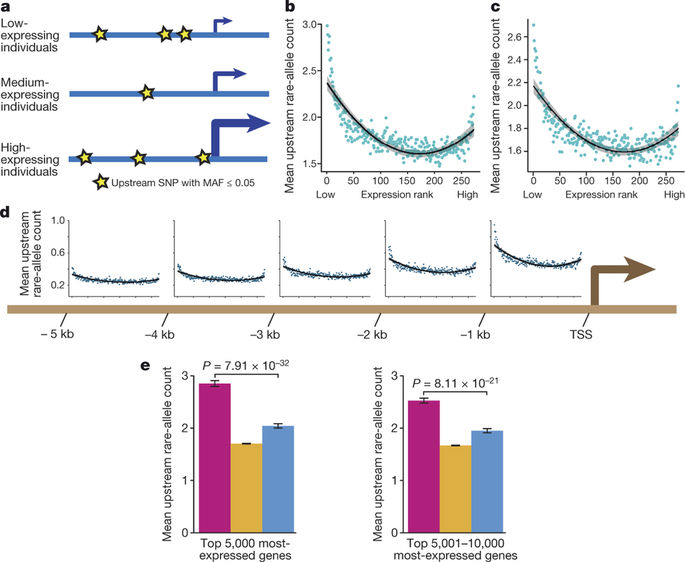Our official English website, www.x-mol.net, welcomes your feedback! (Note: you will need to create a separate account there.)
Dysregulation of expression correlates with rare-allele burden and fitness loss in maize
Nature ( IF 64.8 ) Pub Date : 2018-03-01 , DOI: 10.1038/nature25966 Karl A. G. Kremling , Shu-Yun Chen , Mei-Hsiu Su , Nicholas K. Lepak , M. Cinta Romay , Kelly L. Swarts , Fei Lu , Anne Lorant , Peter J. Bradbury , Edward S. Buckler
Nature ( IF 64.8 ) Pub Date : 2018-03-01 , DOI: 10.1038/nature25966 Karl A. G. Kremling , Shu-Yun Chen , Mei-Hsiu Su , Nicholas K. Lepak , M. Cinta Romay , Kelly L. Swarts , Fei Lu , Anne Lorant , Peter J. Bradbury , Edward S. Buckler

|
Here we report a multi-tissue gene expression resource that represents the genotypic and phenotypic diversity of modern inbred maize, and includes transcriptomes in an average of 255 lines in seven tissues. We mapped expression quantitative trait loci and characterized the contribution of rare genetic variants to extremes in gene expression. Some of the new mutations that arise in the maize genome can be deleterious; although selection acts to keep deleterious variants rare, their complete removal is impeded by genetic linkage to favourable loci and by finite population size. Modern maize breeders have systematically reduced the effects of this constant mutational pressure through artificial selection and self-fertilization, which have exposed rare recessive variants in elite inbred lines. However, the ongoing effect of these rare alleles on modern inbred maize is unknown. By analysing this gene expression resource and exploiting the extreme diversity and rapid linkage disequilibrium decay of maize, we characterize the effect of rare alleles and evolutionary history on the regulation of expression. Rare alleles are associated with the dysregulation of expression, and we correlate this dysregulation to seed-weight fitness. We find enrichment of ancestral rare variants among expression quantitative trait loci mapped in modern inbred lines, which suggests that historic bottlenecks have shaped regulation. Our results suggest that one path for further genetic improvement in agricultural species lies in purging the rare deleterious variants that have been associated with crop fitness.
中文翻译:

表达失调与玉米稀有等位基因负荷和适应性丧失相关
在这里,我们报告了一个多组织基因表达资源,它代表了现代近交玉米的基因型和表型多样性,包括七个组织中平均 255 个品系的转录组。我们绘制了表达数量性状基因座,并描述了罕见遗传变异对基因表达极端情况的贡献。玉米基因组中出现的一些新突变可能是有害的;尽管选择的作用是使有害变异保持罕见,但它们的完全清除受到与有利位点的遗传连锁和有限的种群规模的阻碍。现代玉米育种者通过人工选择和自体受精系统地减少了这种持续突变压力的影响,这暴露了精英自交系中罕见的隐性变异。然而,这些稀有等位基因对现代近交玉米的持续影响尚不清楚。通过分析这种基因表达资源并利用玉米的极端多样性和快速连锁不平衡衰减,我们表征了稀有等位基因和进化历史对表达调控的影响。稀有等位基因与表达失调有关,我们将这种失调与种子重量适应性相关联。我们发现在现代自交系中绘制的表达数量性状基因座中祖先稀有变异的丰富,这表明历史瓶颈已经形成了调控。我们的结果表明,进一步改进农业物种遗传的途径之一在于清除与作物健康相关的罕见有害变异。通过分析这种基因表达资源并利用玉米的极端多样性和快速连锁不平衡衰减,我们表征了稀有等位基因和进化历史对表达调控的影响。稀有等位基因与表达失调有关,我们将这种失调与种子重量适应性相关联。我们发现在现代自交系中绘制的表达数量性状基因座中祖先稀有变异的丰富,这表明历史瓶颈已经形成了调控。我们的结果表明,进一步改进农业物种遗传的途径之一在于清除与作物健康相关的罕见有害变异。通过分析这种基因表达资源并利用玉米的极端多样性和快速连锁不平衡衰减,我们表征了稀有等位基因和进化历史对表达调控的影响。稀有等位基因与表达失调有关,我们将这种失调与种子重量适应性相关联。我们发现在现代自交系中绘制的表达数量性状基因座中祖先稀有变异的丰富,这表明历史瓶颈已经形成了调控。我们的结果表明,进一步改进农业物种遗传的途径之一在于清除与作物健康相关的罕见有害变异。我们描述了稀有等位基因和进化历史对表达调控的影响。稀有等位基因与表达失调有关,我们将这种失调与种子重量适应性相关联。我们发现在现代自交系中绘制的表达数量性状基因座中祖先稀有变异的丰富,这表明历史瓶颈已经形成了调控。我们的结果表明,进一步改进农业物种遗传的途径之一在于清除与作物健康相关的罕见有害变异。我们描述了稀有等位基因和进化历史对表达调控的影响。稀有等位基因与表达失调有关,我们将这种失调与种子重量适应性相关联。我们发现在现代自交系中绘制的表达数量性状基因座中祖先稀有变异的丰富,这表明历史瓶颈已经形成了调控。我们的结果表明,进一步改进农业物种遗传的途径之一在于清除与作物健康相关的罕见有害变异。我们发现在现代自交系中绘制的表达数量性状基因座中祖先稀有变异的丰富,这表明历史瓶颈已经形成了调控。我们的结果表明,进一步改进农业物种遗传的途径之一在于清除与作物健康相关的罕见有害变异。我们发现在现代自交系中绘制的表达数量性状基因座中祖先稀有变异的丰富,这表明历史瓶颈已经形成了调控。我们的结果表明,进一步改进农业物种遗传的途径之一在于清除与作物健康相关的罕见有害变异。
更新日期:2018-03-01
中文翻译:

表达失调与玉米稀有等位基因负荷和适应性丧失相关
在这里,我们报告了一个多组织基因表达资源,它代表了现代近交玉米的基因型和表型多样性,包括七个组织中平均 255 个品系的转录组。我们绘制了表达数量性状基因座,并描述了罕见遗传变异对基因表达极端情况的贡献。玉米基因组中出现的一些新突变可能是有害的;尽管选择的作用是使有害变异保持罕见,但它们的完全清除受到与有利位点的遗传连锁和有限的种群规模的阻碍。现代玉米育种者通过人工选择和自体受精系统地减少了这种持续突变压力的影响,这暴露了精英自交系中罕见的隐性变异。然而,这些稀有等位基因对现代近交玉米的持续影响尚不清楚。通过分析这种基因表达资源并利用玉米的极端多样性和快速连锁不平衡衰减,我们表征了稀有等位基因和进化历史对表达调控的影响。稀有等位基因与表达失调有关,我们将这种失调与种子重量适应性相关联。我们发现在现代自交系中绘制的表达数量性状基因座中祖先稀有变异的丰富,这表明历史瓶颈已经形成了调控。我们的结果表明,进一步改进农业物种遗传的途径之一在于清除与作物健康相关的罕见有害变异。通过分析这种基因表达资源并利用玉米的极端多样性和快速连锁不平衡衰减,我们表征了稀有等位基因和进化历史对表达调控的影响。稀有等位基因与表达失调有关,我们将这种失调与种子重量适应性相关联。我们发现在现代自交系中绘制的表达数量性状基因座中祖先稀有变异的丰富,这表明历史瓶颈已经形成了调控。我们的结果表明,进一步改进农业物种遗传的途径之一在于清除与作物健康相关的罕见有害变异。通过分析这种基因表达资源并利用玉米的极端多样性和快速连锁不平衡衰减,我们表征了稀有等位基因和进化历史对表达调控的影响。稀有等位基因与表达失调有关,我们将这种失调与种子重量适应性相关联。我们发现在现代自交系中绘制的表达数量性状基因座中祖先稀有变异的丰富,这表明历史瓶颈已经形成了调控。我们的结果表明,进一步改进农业物种遗传的途径之一在于清除与作物健康相关的罕见有害变异。我们描述了稀有等位基因和进化历史对表达调控的影响。稀有等位基因与表达失调有关,我们将这种失调与种子重量适应性相关联。我们发现在现代自交系中绘制的表达数量性状基因座中祖先稀有变异的丰富,这表明历史瓶颈已经形成了调控。我们的结果表明,进一步改进农业物种遗传的途径之一在于清除与作物健康相关的罕见有害变异。我们描述了稀有等位基因和进化历史对表达调控的影响。稀有等位基因与表达失调有关,我们将这种失调与种子重量适应性相关联。我们发现在现代自交系中绘制的表达数量性状基因座中祖先稀有变异的丰富,这表明历史瓶颈已经形成了调控。我们的结果表明,进一步改进农业物种遗传的途径之一在于清除与作物健康相关的罕见有害变异。我们发现在现代自交系中绘制的表达数量性状基因座中祖先稀有变异的丰富,这表明历史瓶颈已经形成了调控。我们的结果表明,进一步改进农业物种遗传的途径之一在于清除与作物健康相关的罕见有害变异。我们发现在现代自交系中绘制的表达数量性状基因座中祖先稀有变异的丰富,这表明历史瓶颈已经形成了调控。我们的结果表明,进一步改进农业物种遗传的途径之一在于清除与作物健康相关的罕见有害变异。



























 京公网安备 11010802027423号
京公网安备 11010802027423号